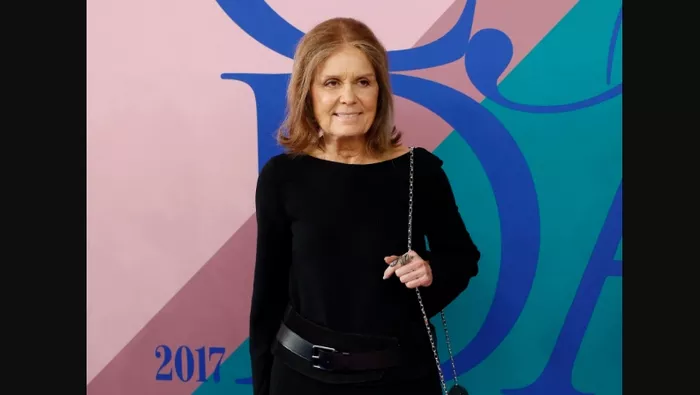Is there anyone cooler than Gloria Steinem? As the world’s most iconic feminist turns 91 on March 25, she continues to exude a unique, captivating presence—still donning her signature look of Concho belts, aviators, and occasionally, sequins and leather.
Steinem’s rise to prominence began in the 1960s, when she became a groundbreaking journalist, writing on topics such as contraception and gender equality. In 1963, she was hired by Show magazine to go undercover as a Playboy Bunny, exposing the exploitative working conditions at the New York club. She co-founded Ms. magazine in 1972, a revolutionary publication for feminists, and became a tireless advocate for women’s rights, including abortion rights and equal pay legislation. Her leadership in the women’s movement has never been questioned.
But today, let’s talk about her fashion—something that has sparked much conversation. Unlike the tailored suits and prim accessories of the 1950s and early ’60s, which were favored by Jacqueline Kennedy, Steinem revolutionized women’s style by introducing a more casual, free-spirited approach. She often wore fitted Henley shirts with flared jeans, low-slung belts, and suede mini skirts paired with knee-high boots or Mary Janes. Oversized jewelry, bold slogans, and highlighted hair rounded out her signature look.
Her style was bold, youthful, and aligned with the Sexual Revolution of the 1960s and ’70s, and it resonated widely.
“She became this new role model,” says Einav Rabinovitch-Fox, historian and author of Dressed for Freedom: The Fashionable Politics of American Feminism. “She wore minis, had a very feminine appearance, and her look became a national trend.”
In 1971, Steinem appeared on the cover of Newsweek under the headline “The New Woman,” accompanied by images of women mimicking her iconic look.
Fashion designer Diane von Furstenberg, a longtime friend of Steinem, shared, “When I was young and in New York during the 1970s, Gloria Steinem was one of my heroes. She was just beautiful; she had so much style.”
However, Steinem’s glamorous appearance also sparked debates around whether a woman could be a feminist and still care about her appearance. Feminism and fashion have had a complex relationship: Can fashion be a form of self-expression, or does it enforce patriarchal norms and gender roles? Is it a way to please others, or a tool for communicating personal values and independence?
These questions have followed many women in the political spotlight. Hillary Clinton faced criticism for dressing too “dowdy” during her time as First Lady, and later for her pantsuit collection. Similarly, Congresswoman Alexandria Ocasio-Cortez was criticized for her $1,000 suit when she graced the cover of Vanity Fair in 2020.
Steinem too has been questioned about her commitment to feminism because of her glamorous style. But this criticism misses the point: Steinem’s message has always been about choice. “Fashion in the past meant conforming and losing oneself,” she said in the 2011 HBO documentary Gloria. “Fashion in the present means being unique and finding oneself.”
Steinem also famously made it clear that a woman could be both a feminist and attractive. “She made it okay to be attractive and to be a feminist,” von Furstenberg said. “She said you don’t need to look like a truck driver [to be a feminist].”
While embracing her personal style, Steinem used fashion to amplify her activism. She was never one to reject fashion but rather to use it as a platform for change. “She’s not a feminist saying we need to reject fashion; she’s saying we can utilize it to get the attention of politicians, and they will listen to us,” said Rabinovitch-Fox.
Steinem’s influence can still be seen today. Designer Michael Kors cited her as an inspiration for his Fall 2023 collection, which featured aviators, low-slung belts, and oversized jewelry. 1970s-inspired flared jeans and micro-minis are making a comeback at fashion houses like Chloe, and designers like Prabal Gurung are increasingly using their fashion shows to promote activism, such as encouraging voter participation.
Her impact also continues to inspire activists. “Steinem’s approach inspired a generation of women to use fashion as a form of rebellion and self-expression,” said Steven Kolb, CEO of the CFDA. He notes that Steinem’s legacy can be seen in Democratic congresswomen wearing white at the State of the Union to show support for women’s rights and to honor suffragists.
For Steinem, the message has always been clear: Fashion is not just about appearance but about making choices. “You can choose who you want to be, and you can choose whatever you want to wear,” says Rabinovitch-Fox. “That’s part of her legacy—choice about your body, your clothes, and your working conditions. You shouldn’t be criticized for the choices you make.”
Steinem’s influence on both feminism and fashion is undeniable, and her legacy will continue to shape both worlds for years to come.
Related Topics
- Arena Offices Donates Clothing to Support Unemployed Women Through Smart Works
- Meghan Markle Launches Online Store for Fashion Favourites and Exclusive Picks
- G-Star Makes Stylish Comeback in Australia, Bringing 2000s Nostalgia with a Modern Twist

